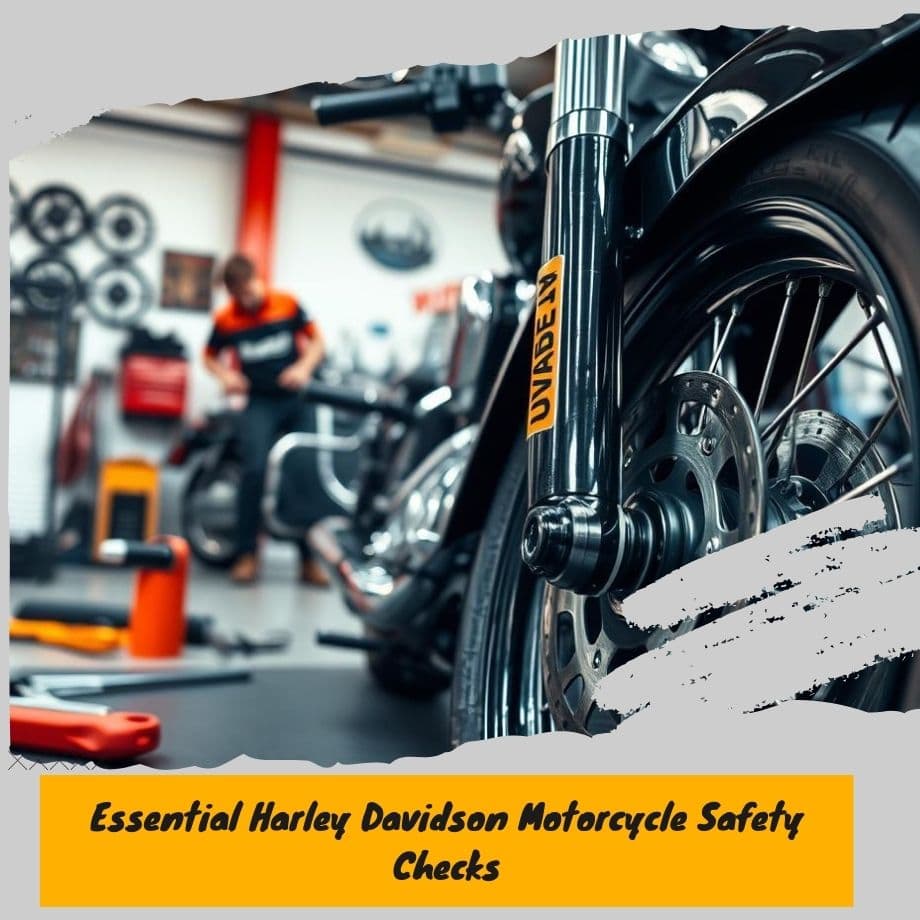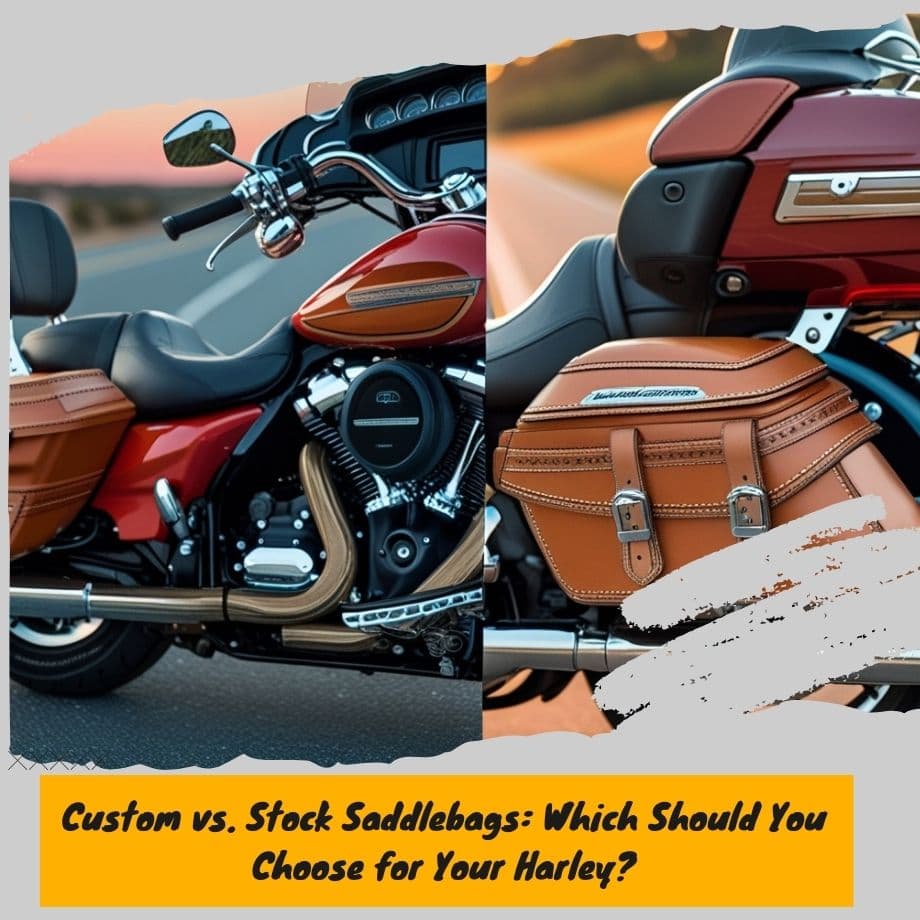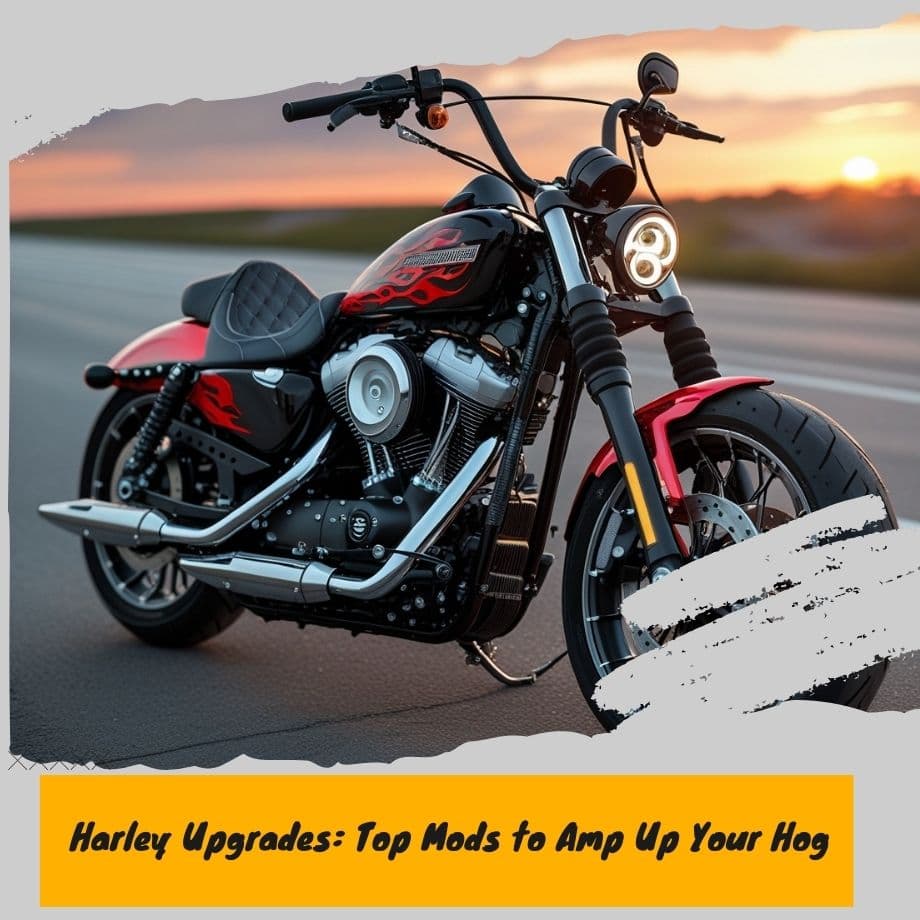Essential Harley Davidson Motorcycle Safety Checks

Regular motorcycle safety checks are key for riders to keep their Harley Davidson in top shape. This helps lower the chance of accidents and makes riding more enjoyable. By doing routine safety checks, Harley Davidson owners can keep their bike running well and safely.
Harley Davidson maintenance includes many tasks, like safety inspections, to keep the bike safe and running right. This guide covers the important safety checks every Harley Davidson owner should do.
Key Takeaways
- Regular motorcycle safety inspections can help reduce the risk of accidents
- Harley Davidson maintenance is essential for ensuring the bike's performance and safety
- Motorcycle safety inspections should be performed routinely to guarantee a safe ride
- Proper maintenance can enhance the overall riding experience
- Harley Davidson owners should prioritize motorcycle safety inspections to ensure their vehicle is in good working condition
Understanding the Importance of Motorcycle Safety Inspections
Regular motorcycle safety inspections are key to spotting issues early. They help riders stay safe on the road. These checks prevent accidents, cut down on repair costs, and meet safety rules.
Wearing safety gear like helmets and gloves is vital. But, safety inspections also check the bike's parts, like brakes and tires. This ensures everything works right.
It's crucial to see why safety inspections are important. They make riding safer. Here are some reasons:
- They lower the chance of accidents by finding problems early.
- They save money by fixing small issues before they get big.
- They make sure riders follow safety rules.
Why Regular Safety Checks Matter
Regular checks find problems before they're big. This lowers accident risks and saves on repairs.
How Often to Perform Safety Inspections
How often to check depends on the bike's age and condition. It also depends on the rider's experience.
The Cost of Neglecting Safety Checks
Ignoring safety inspections can lead to serious issues. It can cause accidents, injuries, and even death. It's vital to use motorcycle safety gear and get regular safety inspections to stay safe.
Pre-Ride Visual Inspection Essentials
Before every ride, it's key to do a pre-ride visual check. This means looking at the motorcycle's tires, brakes, and suspension for wear or damage. A good check can spot issues that might affect safety and performance.
By doing regular pre-ride checks, you're keeping your bike safe and in top shape. This helps avoid accidents and costly fixes. Key areas to check include:
- Tire condition and pressure
- Brake pads and fluid levels
- Suspension and steering components
- Electrical systems, including lights and signals
Sticking to a pre-ride checks routine keeps your bike running smoothly. It's a vital part of motorcycle maintenance and keeps you safe on the road.
Your Complete Harley Davidson Motorcycle Safety Checklist
To make sure your Harley Davidson motorcycle is ready to ride, you need a detailed safety checklist. A good Harley Davidson safety checklist helps spot problems early. It covers checks on documents, safety gear, and the bike's mechanical parts.
Regular safety checks are key to keeping your bike running well and keeping you safe. By using a detailed motorcycle safety equipment checklist, you can avoid accidents and stay safe. Here's what a safety checklist usually includes:
- Documentation and paperwork checks: Make sure all important documents, like insurance and registration, are current.
- Essential safety gear inspection: Check that your helmet, gloves, and jacket are in good shape and meet safety standards.
- Mechanical components overview: Look over the bike's engine, brakes, and suspension to make sure they're working right.
By sticking to a full Harley Davidson safety checklist, you can make sure your bike is safe and meets all safety rules. Always wear the right motorcycle safety equipment and ride safely to lower your risk of accidents.
| Component | Inspection Frequency | Notes |
|---|---|---|
| Tires | Before each ride | Check pressure, tread depth, and look for signs of wear |
| Brakes | Every 1,000 miles | Check pad wear, fluid levels, and look for signs of leakage |
| Engine | Every 5,000 miles | Check oil levels, look for signs of leaks, and verify proper function |
Tire and Wheel Safety Fundamentals
Keeping tires in good shape is key for tire safety and car performance. Regular checks can stop accidents and lower the chance of tire problems. One key part of tire care is keeping the right tire pressure.
Checking tire pressure is easy and helps a lot. It's important to check it at least once a month. Underinflated tires can cause problems like bad traction and longer stopping times. They also use more fuel. Plus, the right pressure makes tires last longer and improves how the car handles.
Proper Tire Pressure Guidelines
Look in the car's manual or the tire placard on the driver's side door for the right pressure. Always check pressure when the tires are cold. Driving can warm them up and change the pressure reading.
Tread Wear Indicators
Tread wear indicators are key for checking tire condition. They are small bars or marks on the tire that show when the tread is too low. Checking these can spot worn-out tires and prevent accidents from wheel alignment problems.
Regular wheel alignment checks also prevent uneven tire wear and better car handling. By following tire care tips and keeping up with tire safety and wheel alignment, riders can greatly lower the risk of tire accidents. This ensures a safe and fun ride.
Brake System Inspection Protocol
A thorough brake system inspection is key for your motorcycle's safety and performance. The brake system is vital, and problems can be serious. Regular checks can spot issues early, avoiding big safety risks.
During an brake system inspection, several parts need attention. This includes brake pads, rotors, calipers, and brake fluid levels. A structured check ensures your motorcycle brakes work right and makes any needed fixes.
- Brake pad wear and condition
- Rotor condition and thickness
- Caliper function and condition
- Brake fluid level and condition
Regular checks and upkeep of your motorcycle brakes keep you safe on the road. A well-kept brake system is crucial for safe riding.
A well-maintained brake system is the foundation of safe and confident riding. Regular inspection and maintenance can help prevent accidents and ensure a smooth ride.
Fluid Levels and Quality Checks
Checking fluid levels is key to keeping a motorcycle running well. This means looking at engine oil, checking brake fluid, and making sure coolant levels are right. Keeping fluids at the right levels and quality helps avoid overheating, corrosion, and engine damage.
Here are some important things to remember when checking fluid levels:
- Regularly check fluid levels to avoid overheating and corrosion
- Look for signs of contamination or wear in engine oil
- Make sure brake fluid levels are correct for safe braking
Always refer to your motorcycle's manual for the best way to check and maintain fluids. Also, know the signs of low or dirty fluids, like poor performance, high temperatures, or odd noises.
Electrical System Safety Verification
Keeping your motorcycle's electrical system safe is key for a safe ride. It powers important safety items like lights, signals, and the horn. If it fails, it can cause accidents, which is a big risk at night or in dark places. So, checking the electrical system often is a must to stay safe.
Checking the battery health is a big part of this. A good battery keeps everything running right. Riders should look for corrosion on the terminals, make sure the battery is tight, and check the electrolyte level. They should also test the battery's voltage and charging system to make sure they work well.
Battery Health Check
- Check battery terminals for corrosion
- Ensure the battery is properly secured
- Check the electrolyte level
- Test the battery's voltage and charging system
Inspecting the lighting system is also crucial. This means checking the headlights, taillights, brake lights, and turn signals. Riders need to make sure all lights work and are not damaged. Good lighting helps you see and be seen by others.
Lighting System Inspection
Don't forget to test the horn and signals too. They help you talk to other drivers and avoid crashes.
| Component | Function | Safety Importance |
|---|---|---|
| Headlights | Illuminate the road ahead | High |
| Taillights | Indicate the motorcycle's presence to other road users | High |
| Brake lights | Indicate when the motorcycle is slowing down or stopping | High |
| Turn signals | Indicate the motorcycle's intention to turn or change lanes | High |
By following these steps, riders can stay safe and avoid accidents. Regular checks of the electrical system are vital for a safe ride. They should be done often as part of the bike's upkeep.
Chain, Belt, and Drivetrain Maintenance
Regular chain maintenance is key for a motorcycle's best performance. It means checking the chain for wear, adjusting or replacing it when needed, and keeping the drivetrain in good shape. This helps avoid breakdowns, reduces wear on other parts, and boosts the motorcycle's performance.
Belt replacement is also vital. The belt can wear out over time, affecting performance and increasing the risk of a breakdown. It's important to replace the belt as recommended to keep the drivetrain working well. Some important tips for chain and belt care include:
- Regularly check the chain or belt for wear signs
- Adjust or replace the chain or belt as needed
- Keep the drivetrain clean and well-lubricated
By following these tips and keeping up with chain and belt maintenance, riders can ensure their motorcycle runs smoothly and efficiently.
| Component | Maintenance Interval | Description |
|---|---|---|
| Chain | Every 500 miles | Inspect and adjust chain tension |
| Belt | Every 20,000 miles | Replace belt |
| Drivetrain | Every 10,000 miles | Inspect and lubricate drivetrain components |
By focusing on chain, belt, and drivetrain maintenance, riders can make their motorcycle last longer and perform better. Regular care also helps avoid expensive repairs and reduces the chance of breakdowns.
Emergency Equipment and Tools
Being ready for emergencies is key to motorcycle safety. It means having the right tools, knowing who to call, and knowing how to fix simple problems. A good tool kit helps riders deal with common issues and stay safe.
Along with a tool kit, having emergency equipment like a first aid kit and spare tire is crucial. It's also important to have emergency contact info, like roadside assistance and insurance numbers, handy.
Some must-haves for a tool kit are:
- Socket set
- Pliers and wrenches
- Screwdrivers
- Tire pressure gauge
- Basic toolkit
Having the right emergency equipment and tool kit is vital in emergencies. It's also key to know how to use them. Riders should get to know their tool kit and practice using the tools before riding.
Being prepared and having the right emergency equipment and tool kit reduces accident risks. It ensures a safe and fun ride.
| Tool Kit Item | Description |
|---|---|
| Socket set | Used for tightening and loosening bolts and nuts |
| Pliers and wrenches | Used for gripping and twisting objects |
| Screwdrivers | Used for driving screws and other fasteners |
Conclusion: Ensuring Your Harley's Safety and Performance
Maintaining your Harley Davidson's safety and performance is key for all riders. Regular safety checks and following a detailed checklist are essential. This keeps your Harley in top shape, whether you're riding or parked.
The safety and performance of your Harley are closely tied. Focusing on safety means you protect yourself and others. It also keeps your motorcycle reliable and performing well for a long time. With a focus on safety and maintenance, your rides will be safer, more exciting, and rewarding for years.
FAQ
What are the essential Harley Davidson motorcycle safety checks?
Harley Davidson motorcycle safety checks include a few key steps. First, do a pre-ride visual inspection. Then, check your documentation and safety gear. Lastly, examine the motorcycle's mechanical parts.
Why are regular safety checks important for Harley Davidson motorcycles?
Regular safety checks help find problems early. This prevents accidents and saves money on repairs. It also keeps you safe and in line with safety rules.
How often should Harley Davidson owners perform safety inspections?
Harley Davidson owners should check their bikes before every ride. They should also do regular maintenance checks as recommended. This keeps the motorcycle in top shape.
What are the consequences of neglecting safety checks on a Harley Davidson motorcycle?
Ignoring safety checks can cause serious issues. It can lead to high repair costs and safety risks. It also might mean you're not following safety rules, which increases the chance of accidents.
What are the key components to include in a Harley Davidson motorcycle safety checklist?
A good safety checklist covers many areas. Check your documents and safety gear first. Then, look at the mechanical parts, tires, brakes, fluids, and electrical system. Don't forget the chain, belt, and drivetrain.
How can Harley Davidson owners ensure their motorcycle's tires and wheels are safe?
To keep tires and wheels safe, check the pressure and tread. Make sure the wheels are aligned correctly. This ensures your bike handles well and safely.
What is the importance of a thorough brake system inspection for a Harley Davidson motorcycle?
Brake system inspections are vital. They check if the brakes are working right. Look at the pads, rotors, calipers, and fluid levels to ensure safety.
Why are fluid level and quality checks important for a Harley Davidson motorcycle?
Fluid checks keep your bike running well. Check the oil, brake fluid, and coolant levels. This prevents overheating and damage to the engine.
How can Harley Davidson owners ensure the electrical system of their motorcycle is safe?
Check the battery and lighting system regularly. Test the horn and signals too. This keeps you visible and safe on the road.
What are the key components of a Harley Davidson motorcycle's emergency equipment and tool kit?
Your emergency kit should have basic tools for repairs. Include important contact info and know how to fix common problems. This helps you handle issues on the road.







Leave a comment